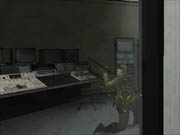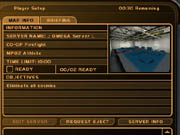The Sum of All Fears motion picture is out, and so is the PC game, which uses the same graphics engine as Ghost Recon. And like Ghost Recon, Rogue Spear, and Red Storm's other shooters that bear the Tom Clancy name, it's a tactical shooter in which you undertake missions in modern-day, real-world locations, though this time the game takes place in several of the locations featured in the movie. And while it seems pretty clear that some parts of the game were rushed to get it onto store shelves in time for the movie's release, The Sum of All Fears is still a solid team-based shooter that's surprisingly accessible, even for new players.

If you're new to tactical shooters, you may not know that they generally involve you playing as a character with a few computer-controlled teammates whom you can order to provide cover for you, clear passageways, and stand guard. Unfortunately, a lot of tactical shooters can be difficult to pick up and play for new players--they move much more slowly than arcade-style first-person shooters like Quake III and Serious Sam, and if you take just one good shot from an enemy, you're dead. But if you are new to such games, you won't have too much trouble getting started with The Sum of All Fears, since the game comes with a full training mission, as well as a lot of helpful features to help you get started. Like other Tom Clancy games before it, The Sum of All Fears has a minimap for each mission that clearly indicates where you need to go next in order to accomplish your next objective. But the game also has some handy options on the easy difficulty mode; for instance, the heartbeat sensor remains permanently active--this item detects enemy soldiers, and in previous games, you couldn't use it and a gun at the same time. Also, easy difficulty lets you auto-aim, which snaps your gun sight directly onto an enemy tango--all you need to do is pull the trigger.
The Sum of All Fears may be a multimillion-dollar summer movie, but the game isn't quite as spectacular. That's not to say that The Sum of All Fears looks bad--the game has some good-looking character models and some good-looking death animations when you take down your enemies. Unfortunately, even though the game has a decent number of maps (11 single-player maps, plus seven multiplayer maps), a lot of the game's environments look rather plain. And the actual levels are pretty standard for a tactical shooter: Among other things, the game has a Middle Eastern military base, an underground network of caves and sewers, an office building, a warehouse, and a richly furnished mansion. If you've played other tactical shooters before, you shouldn't expect to see too many new things in the game's levels. And like most other such games, The Sum of All Fears' environments aren't very interactive. You can open a few doors, pick up and manipulate a few objects, and that's basically it--other than the game's glass windows, which, for some reason, tend to shatter loudly a second or two after they're shot out. Don't expect to see any walls or buildings destroyed by movie-style explosions or any out-of-control vehicles smashing through gates.
Shattering glass, gunshots, death cries, and nearly all of The Sum of All Fears' other sound effects are short, clearly and effectively indicate what just happened, and are convincing enough. The game also makes limited use of 3D sound in a few areas (this is especially apparent in the sewer level of the second single-player mission), though it's really more of a gimmick than anything else. Your best indicator of where your friends and enemies are is your heartbeat sensor and your minimap. Otherwise, The Sum of All Fears has a quiet, barely noticeable soundtrack, passable voice acting for the mission briefings, and decent voice samples for the terse orders and signals that you and your teammates exchange whenever you take down an enemy, drop a grenade into a room, or take a hit.

Beyond that, The Sum of All Fears plays like a slightly more streamlined version of Ghost Recon. Again, the developers apparently simplified several aspects of the game for beginners who might pick it up based on their interest in the motion picture. For instance, The Sum of All Fears has a much-simplified planning phase--all you do is choose which weapons you and your squadmates will carry, and that's it. Your squadmates don't have any kind of ability scores, and they're all exactly the same. They get replaced only when they die, and unlike in previous Tom Clancy games, you don't "buy" more experienced soldiers later on in the game, either.
The single-player game has the same sort of pacing as a lot of tactical shooters: lots of quiet, slow parts in which you advance through the level, punctuated by short, extremely quick firefights with enemies. To help you out, you can bring up a command menu to give direct orders to your teammates. The command menu is considerably different from (and simpler than) Ghost Recon's, since that game took place in large, open locations, while The Sum of All Fears mostly takes place in enclosed areas. You can order your teammates into two formations, have them follow you or stay in one place, and have them approach closed doors and open, clear, or toss a grenade through them.

Your teammates tend to be a lot more useful than in the original release of Ghost Recon, simply because there's less space for them to wander around, and they can actually be quite helpful when it comes to clearing small rooms that have only one or two enemies. However, they're unreliable in larger fights, as they'll sometimes blunder into an enemy's line of sight and draw fire before you can suppress your enemies with a flashbang or grenade. They also have an unfortunate tendency to block doorways just as you enter them and to block your line of sight, which is a problem in rooms with multiple enemies. Finally, in accordance with the film, you play as part of a government strike force, so in several of the levels, you'll receive "support" from larger teams of computer-controlled troops. These troops can be helpful in larger fights, but they're just as likely to blow your cover and block your fire as your squadmates. You'll run into several chaotic situations in which you're about to close with an enemy, only to have your support troops storm into the room firing wildly and shouting that they've sighted hostiles, taken down enemies, taken wounded, or taken casualties before you can even move a muscle. And unfortunately, though this happens pretty rarely, your squadmates will sometimes still get stuck on objects and walls and have to be coaxed back in line. This can be mildly annoying in some of the game's stealth missions, which require you and your squadmates to all return to an extraction point at the very end.
If it weren't for the problems with your squadmates, The Sum of All Fears' levels would be more enjoyable to navigate and conquer. They'd be even better if it weren't for the heavily guarded choke points, which appear on different levels and on different difficulty settings. You'll breeze through most parts of a level, but you'll invariably come to a point at which you'll have to save and reload your game, because your teammates keep getting killed by enemy fire or because you simply can't take out all four of the guys guarding that narrow stairway. You can win these battles by trial and error, but the constant saving and reloading detracts from the experience considerably. And unfortunately, if it weren't for these impasses, you'd be able to finish The Sum of All Fears' single-player game in a flash. The game has only 11 single-player missions, and even on the hardest difficulty, you'll probably be able to solve them in about 10-15 hours--less if you play on the easier settings. And when you do complete the single-player game, the only ending you'll receive will be the roll of the credits.

Fortunately, The Sum of All Fears has a few options that help extend the life of the game somewhat. The game has been running multiplayer sessions on Ubi Soft's ubi.com online game service ever since May 31, and though there aren't exactly thousands of people playing, we had no trouble finding a pickup game. The Sum of All Fears has the same sort of multiplayer modes as Ghost Recon, including last man standing (an elimination deathmatch), team deathmatch, and cooperative hostage rescue. Multiplayer play is considerably more interesting than the single-player campaign. However, since you can be taken out by a single good shot or two, you'll need to make sure your server administrator sets unlimited respawns--otherwise you'll find even longer breaks between gunfights, since you'll not only be slowly sneaking through the game's corridors and rooms, but you'll also be sitting on the sidelines until the next round begins if you get eliminated. The Sum of All Fears also has single-player skirmishes that let you play through each of the single-player missions, fill them with more enemies, and go at it with teammates or alone. It's a bit more interesting to go at the game's missions by yourself, without teammates. Though like in the single-player campaign game, you may have undue trouble getting past large ambushes.
While it's clear that The Sum of All Fears was rushed for the movie's release, it's a surprisingly solid game. Though the single-player campaign game is too short, the multiplayer is decent, and a few of the game's single-player modes are interesting enough to warrant a few tries. What's more, The Sum of All Fears is easily one of the most accessible tactical shooters ever made, so it's a good starter game for beginners.